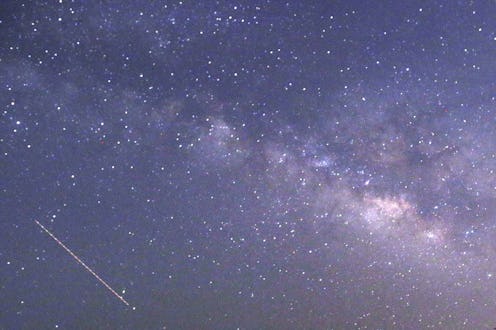Get excited, astronomy fans! If you're a lover of gorgeous sights in the skies, you're in luck, because the annual meteor shower known as the Eta Aquarids is happening soon! When is the Eta Aquarids meteor shower, you might be wondering? In 2016, the meteor shower will peak during predawn hours on Thursday and Friday (May 5 and 6), so you'll have to get up (or stay up) pretty early to catch the activity in live-time. This means that the window to see the meteors actually started this morning; however, you can still catch the beauty tomorrow morning (or depending on how late you stay up, tonight).
If you're not already a huge astronomy nerd like myself (or even if you are), you might be wondering what the Eta Aquarids are. Good news: I have some answers for you. The Eta Aquarids are debris from Halley's Comet, which was last seen in 1986 and which won't be visible from Earth again until 2062. At least the meteor showers spawned by the comet come by once a year, though, right? All meteor showers are essentially the dust of comets or asteroids; they become visible to us when the Earth rotates into their trails, and the streaks light we see are the the debris basically disintegrating in our atmosphere. Neat, right? Eta Aquarids are also known for their awesome speed: NASA estimates that they travel at the speed of 44 miles per second.
You'll want to be in the darkest spot possible to view this gorgeous sight, although your visibility will largely depend on where you're located when the shower happens. If you're in the Southern Hemisphere, you're likely to have a much easier time viewing the shower than if you are (like me) in the Northern Hemisphere. For example, if you're located in Texas or Florida, you'll have an awesome chance to witness the meteor shower at full-bloom, between around 1:30 a.m. and dawn; however, if you live further north, like in Washington, D.C. or New York City, you're basically out of luck to see the actual meteor shower.
But if you're located in a northern location, you needn't give up hope! ! It's possible you can still catch what's called an Earthgazer. Earthgazer meteors are a sight to wonder in themselves; basically, they skim the top of the Earth's atmosphere and appear a meteor shower is near the horizon. The meteoroids then streak horizontally overhead rather than down through the sky.
If you miss the Eta Aquarids entirely (either because, like me, you inevitably sleep through it, or because the sky conditions are just too bleak to catch a glimmer), don't fret! In October 2016, we can expect another meteor shower also stemming from Halley's Comet, called the Orionids.
Image: Giphy
